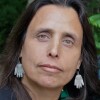November is known as Gashkaadino Giizis, the Frozen Moon, in Anishinaabemowin. This is what we all hope for in the North, a time when winter puts everything to sleep, when the great white blanket descends, when the trees are covered in ice and snow and when the quality of the ice matters. It’s a delicate balance, and it’s a matter of life and death, of course.
Sometimes someone asks me how the Ojibwe know when it’s time to go on the lake ice. My usual answer is “when the last white man fell in the water”. A sad but true answer.
It’s the time of year when people think they’re invincible. Driving on icy roads with a four-wheel drive vehicle is still something to be reckoned with. Navigating thin ice is another invincible thing, of course, and then there’s just doing stupid things and thinking technology will save us.
It’s not just the roads, it’s the way of life: keep pushing, and act like technology is going to save us. I think the Creator has a different understanding and perhaps the long term is to better understand moderation, self-regulation, fear and, ultimately, respect.
Every day we do stupid things: smoke cigarettes, eat or drink excessively, and we assume we can fix it. I’m at the age where I might get a new knee or hip one of these days. So I hope that some technology can save me too. It’s good technology or appropriate technology, but for now I’m just going to take care of my physical body.
Not all technology is good, and some of the best new ideas aren’t actually good at all, we’ll find out a little later. Take Teflon, for example. Teflon pans appeared in 1954 after Dupont chemists discovered special substances that did not burn. This product is part of a group of chemicals called polyfluoroalkyl substances (PFAS).
After Teflon, PFAS appeared in food packaging, furniture, firefighting foam, my black spatula and even clothing. Today, more than 6,000 PFAS chemical compounds are in commercial use. This substance is not going away and is present everywhere, from our blood and breast milk to our water. Industry response: “Put a lot more money into cancer research in search of a cure. » The “cure” is to stop doing stupid things.
Next, look at the carbon in the air. The last Trump administration asked the Environmental Protection Agency to remove the climate change page from its website. This is another way of avoiding things and acting invincible: just shut up and don’t talk about it.
Meanwhile, new technological solutions are being hailed as carbon sequestration wonderland. Take that Milton R. Young powerhouse over there in Oliver County, North Dakota. The plant produces at least 5 million tonnes of carbon per year and was built 50 years ago. An answer? Stop it and maybe find other sources of energy (even for this big crypto and become more efficient). But no, once again, technology will save us.
Enter Project Tundra. Known to capture 95% of CO2 in a special treatment system, it is somewhat of a sophisticated set of equipment, cleaning, chemicals, etc. Todd Leake, who farms near Grand Forks and heads the small but mighty Sierra Club, submitted a challenge to the Department of Energy. The ministry’s own draft environmental assessment found that if the entire life cycle, from coal mining to electricity distribution, is taken into account, the project will still emit significantly more carbon dioxide than it will capture.
“It borders on the absurd to approach the future of electricity generation in North Dakota with this type of production model,” Leake said. “There is a safe way to sequester carbon from a coal-fired power plant. And that leaves the coal in the ground. It’s already sequestered by nature.
Bad news: There may be no carbon sequestration fairy.
Well, except hemp, which sucks up 10 tons of carbon dioxide per hectare. Seems like more technology isn’t the answer, but maybe a factory will help. This could well be the carbon sequestration fairy.
My humble suggestion as a mother of five sons and grandmother of at least five other testosterone-filled young men is this: don’t do stupid things in the first place. Neither technology nor your grandmother can always save you. You are not invincible.
There you go, we have just finished Gashkaadino Giizis, the frozen moon of the Anishinaabe. I think the last white guy has fallen, or at least his truck, so I might venture out on skis. I’m using this time to slow down, not speed up. And I’m going to encourage the 200,000 people who go ice fishing on our lakes to “leave no trace” because there is no real way to clean up raw sewage and cooler waste.
There is only one plan to keep it clean and remove everything you bring. The lake is not invincible.
This is, in a way, the way to survival: don’t do stupid things because no one will save you, don’t leave any traces and, finally, remember that you are not invincible.
Winona LaDuke is an Ojibwe writer and economist from the White Earth Reservation in Minnesota. She is also co-curator of the Giiwedinong Museum in Park Rapids, Minnesota, and a regular contributor to Forum News Service.



